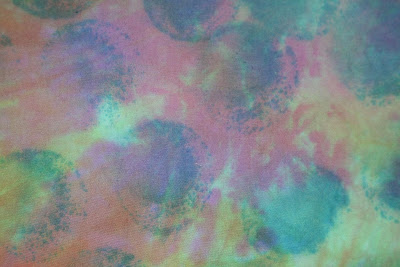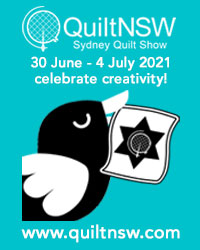It looked pretty naked, so I filled in the background with other colours of thickened dye using a small paintbrush and the round sponges stamps. Because the fabric was wet, the background stuff washed across the fabric.

 This is really the only one that I like from the entire lot. I'm thinking about entering it into the Sydney Quilt Festival in June. To cut or not to cut ... that is the question.
This is really the only one that I like from the entire lot. I'm thinking about entering it into the Sydney Quilt Festival in June. To cut or not to cut ... that is the question.I tried all these techniques from the last couple of blog posts in a workshop I took recently and confess that I have learned a couple of things that I didn't expect to learn.
First of all, working with thickened dyes really isn't that much fun. Cooking the resists, mixing up the soda ash and soaking fabrics to make them nice and slimy and smelly, gallons of water washing things out again and again ... lots of work for some pretty mediocre results. I think that the fabrics looked better before they were dyed. OK, the potato resist ones aren't too bad. But I think that I'll stick to fabric paints and inks and give the dyes a miss.
Second, I should have brought white or light coloured fabrics to the workshop. The samples I haven't shown you were too dark to start off with and just ended up, well, darker.
Third, thickened black dye doesn't separate into different colours like black ink does when you apply it to very wet fabric. All it does is turn your fabric ... wait for it ... black. I didn't show you that one because, well, you've seen black fabric before.
And, finally, I am really not very good at workshops. Other people really get into the spirit of the thing and have a great time, so it must be me. I find the pace too slow, too much time wasted waiting around, getting that vital piece of information just moments after it is too late and the almost guaranteed disappointment with the results.
Don't get me wrong. Some of the stuff I've posted isn't really that bad. But I think that I liked the hand-dyed fabrics more before I used them at the workshop.
Fortunately, I have a couple more bits tucked into my stash and have a very reliable source for more.






















































